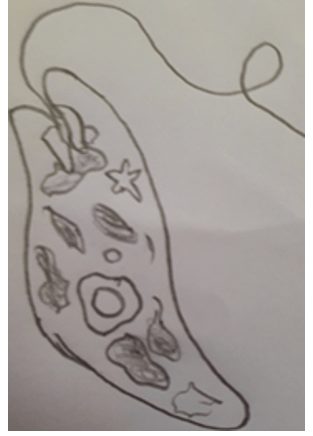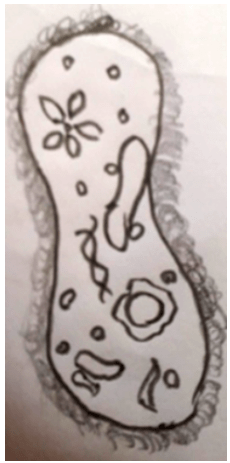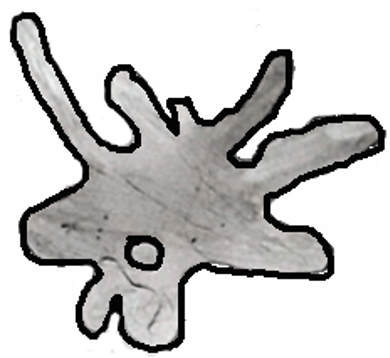This set of Class 11 Biology Chapter 2 Multiple Choice Questions & Answers (MCQs) focuses on “Biological Classification – Protista – 2”.
1. Which among the following statements are incorrect about the given organism?

a) They are found in stagnated fresh water
b) They have a rigid cell wall made up of pellicle
c) They contain chlorophyll and can make their own food in presence of sunlight
d) They have two flagella with one being shorter than the other
View Answer
Explanation: The given picture shows Euglena. Euglenoids are present in stagnated fresh water and don’t have cell wall. They instead have a protein rich layer called pellicle which makes their body flexible. They contain chlorophyll which helps them to prepare their own food and in absence of sunlight they are heterotrophic and act as predators. They have two flagella with one being shorter than the other.
2. Euglenoids are flexible due to ___________
a) Pellicle
b) Pectin
c) Chitin
d) Cortex
View Answer
Explanation: Euglenoids have a protein rich layer called pellicle which makes their body flexible. Euglenoids have two flagella that help in their movement. Euglena changes its body shape during its movement and this phenomenon called as metaboly is possible due to pellicle.
3. Which among the following are saprophytic protists?
a) Euglenoids
b) Protozoans
c) Dianoflagellates
d) Slime moulds
View Answer
Explanation: Slime moulds are considered to be fungus like protists since they grow in moulds and reproduce using spores. But there are many differences between Slime moulds and fungi. Unlike fungi, slime moulds lack chitin in their cell wall and are mobile.
4. Slime moulds grow on ______
a) Oceans
b) Fresh water
c) Dead and decay mater
d) Hills
View Answer
Explanation: Slime moulds grow on dead and decay matter. Under favorable conditions, they aggregate to form plasmodium which grows and spreads across several feet. If the conditions weren’t favorable they form a food bearing spores at their tips which are extremely resistant and get dispersed by air currents.
5. Which among the following are incorrect statements?
a) Slime moulds feed on bacteria, yeast and fungi and have amoeba like food ingestion
b) The pigments in Euglena are identical to that of higher plants
c) Slime moulds reproduce either by forming an aggregate called plasmodium or by spore formation
d) All the other protists except Slime moulds have cell wall
View Answer
Explanation: Like Slime moulds, Protozoans also don’t contain cell wall. Slime moulds feed on bacteria, yeast and fungi and have amoeba like food ingestion. The pigments in Euglena are identical to that of higher plants. Slime moulds reproduce either by forming an aggregate called plasmodium or by spore formation.
6. Which among the following are incorrect about the reproduction in slime moulds?
a) During favourable conditions, slime moulds form an aggregation called plasmodium which may grow and spread over several feet
b) Under favourable conditions, slime moulds form fruiting bodies bearing spores at their tips which then get dispersed through air currents
c) The spores possess true walls that is resistant to adverse conditions
d) Slime moulds reproduce either by sexual or by asexual reproduction
View Answer
Explanation: Slime moulds can reproduce either sexually or asexually. During favourable conditions they form an aggregation called plasmodium which may grow and spread over several feet. Under unfavourable conditions, plasmodium differentiates to form fruiting bodies bearing spores at their tips which then get dispersed through air currents. Slime moulds reproduce either sexually or asexually.
7. Protozoans are animal like protists.
a) True
b) False
View Answer
Explanation: Protozoans are animal like protists because they are mobile and are predators. Protozoans comprise of amoeboids, flagellated protozans, ciliated protozoans and sporozoans.
8. Pseudopodia help amoeboids in _______
a) locomotion
b) ingestion of food
c) locomotion and ingestion of food
d) performing metabolic reactions
View Answer
Explanation: Pseudopodia help amoeboids in both locomotion and ingestion of food. Pseudopodia are temporary extensions in amoeba that help them to move to as well as intake food by surrounding it with temporary extensions.
9. Amebiasis is caused due to _______
a) Amoeba proteus
b) Entamoeba hystalica
c) Chaos carolinense
d) Trypanosoma
View Answer
Explanation: Entamoeba hystalica is a parasitic amoeba in human which in turn causes Amebiasis. Amebiasis results in abdominal pain, diarrohoea, blood in stool, fever and loss of appetite.
10. In the organism shown in the figure, food is in taken by ______

a) Pseudopodia
b) Cilia
c) Gullet
d) Vacuole
View Answer
Explanation: The given figure shows paramoecium. Food is in taken by gullet in Paramoecium. Paramoecium has cilia which perform rhythmic movement which leads in steering of food containing water into the gullet.
11. Movement in paramoecium is due to ______
a) gullet
b) photo-receptors
c) cillia
d) radiating canals
View Answer
Explanation: Movement in paramecium is due to hair like structures called cilia that grows on its body. Paramoecium can move actively due to the presence of thousands of cilia. Cilia performs rhythmic movement in order to steer food containing water into the gullet.
12. Sleeping sickness is due to ________
a) Trypanosoma
b) Entamoeba hystalica
c) Noctiluca
d) Golden algae
View Answer
Explanation: Trypanosoma is a flagellated protozoan that is parasitic and causes sleeping sickness. Sleeping sickness causes joint and muscle pains. It results in behavioural changes, confusion and poor coordination.
13. Which among the following are non-mobile protozoa?
a) Sporozoans
b) Chrysophytes
c) Euglenoids
d) Amoeboids
View Answer
Explanation: Sporozoans are non-mobile and therefore don’t have cilia. They are mostly parasitic and depend on host to meet their food requirements. They reproduce by spore formation.
14. All protozoans are either parasitic or predators. They depend on other animals for their food.
a) True
b) False
View Answer
Explanation: All protozoans are either parasitic or predators. They depend on other animals for their food. They don’t contain chlorophyll and so can’t prepare their own food. This is why protozoans are considered as animal like protists.
15. The organism shown in the following figure reproduces by _________

a) Binary fission
b) Spore formation
c) Budding
d) Fragmentation
View Answer
Explanation: The above figure shows amoeba. Amoeba reproduces by binary fission in which the parent organisms expands initially and then divides into two daughter cells with equal cytoplasma and genetic material.
Sanfoundry Global Education & Learning Series – Biology – Class 11.
To practice all chapters and topics of class 11 Biology, here is complete set of 1000+ Multiple Choice Questions and Answers.
If you find a mistake in question / option / answer, kindly take a screenshot and email to [email protected]
- Check Class 11 - Books
- Practice Class 11 - Physics MCQs
- Practice Class 11 - Mathematics MCQs
- Practice Class 11 - Chemistry MCQs
- Practice Class 12 - Biology MCQs
